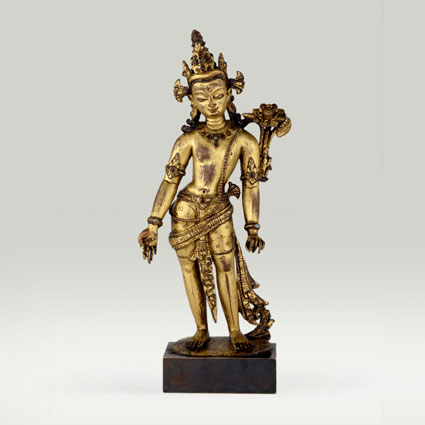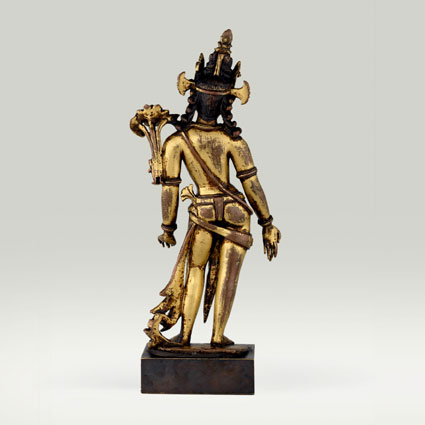Avalokiteshvara Padmapani – The "Lotus Bearer"
See it in the Museum

India and Nepal
Orientation 4
Display 6

ABS 123
Code: ABS 123
Country: Nepal
Style: Early Malla Period
Date: 1250 - 1350
Dimensions in cm WxHxD: 8.1 x 23 x 5.8
Materials: Gilt copper
Avalokiteshvara Padmapani (tib.: Chagna Padmo) is the one of the most revered bodhisattvas in Mahayana Buddhism. He is standing in a gracefully inclined attitude on an oval pedestal. His right hand is extended in the gesture of charity (varada-mudra), and the left hand originally held the separately cast stalk of the lotus (padma) blossoming at his left shoulder. Avalokiteshvara is clad with a cloth (dhoti) tied around his waist with a belt with folds falling down at the front, and a sash is tied around his hips. He wears princely ornaments: a crown, a pair of earrings, a necklace and the “investiture with the sacred thread” (upavita).
Bodhisattvas are beings that have generated bodhicitta (mind of enlightenment), and vowed to help all sentient beings until each and every one is free from suffering. Bodhisattvas can live incarnated in this world or dwell in a subtle body in the realm of sambogakaya, where they can be reached through meditation. Bodhisattvas are also named “the Buddhas lions”. Bodhisattvas put into practise the six basic paramitas(virtues): charity, morality, patience, effort, concentration and wisdom (dana, sila, ksanti, verya, dhyana and prajna) and the four paramitas which derive from the basic ones: skillful means, vows, power and knowledge (upaya, pranidhana, bala and jnana). Among the many, there are eight great or divine bodhisattvas. In the Nispanna Yogavali of Mahapandita Abhayakara Gupta three sets of sixteen bodhisattvas are mentioned.
Bodhisattvas are beings that have generated bodhicitta (mind of enlightenment), and vowed to help all sentient beings until each and every one is free from suffering. Bodhisattvas can live incarnated in this world or dwell in a subtle body in the realm of sambogakaya, where they can be reached through meditation. Bodhisattvas are also named “the Buddhas lions”. Bodhisattvas put into practise the six basic paramitas(virtues): charity, morality, patience, effort, concentration and wisdom (dana, sila, ksanti, verya, dhyana and prajna) and the four paramitas which derive from the basic ones: skillful means, vows, power and knowledge (upaya, pranidhana, bala and jnana). Among the many, there are eight great or divine bodhisattvas. In the Nispanna Yogavali of Mahapandita Abhayakara Gupta three sets of sixteen bodhisattvas are mentioned.




